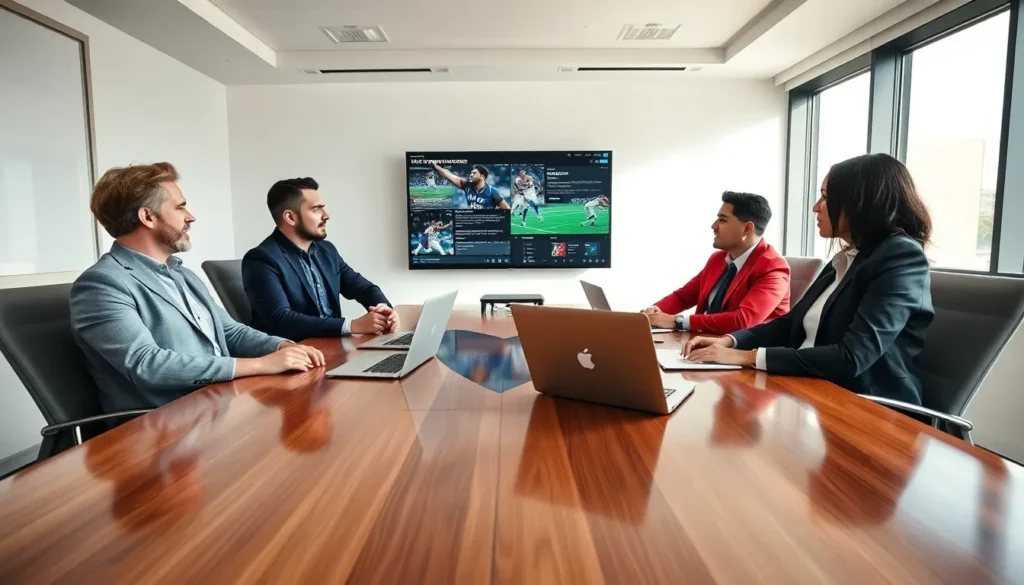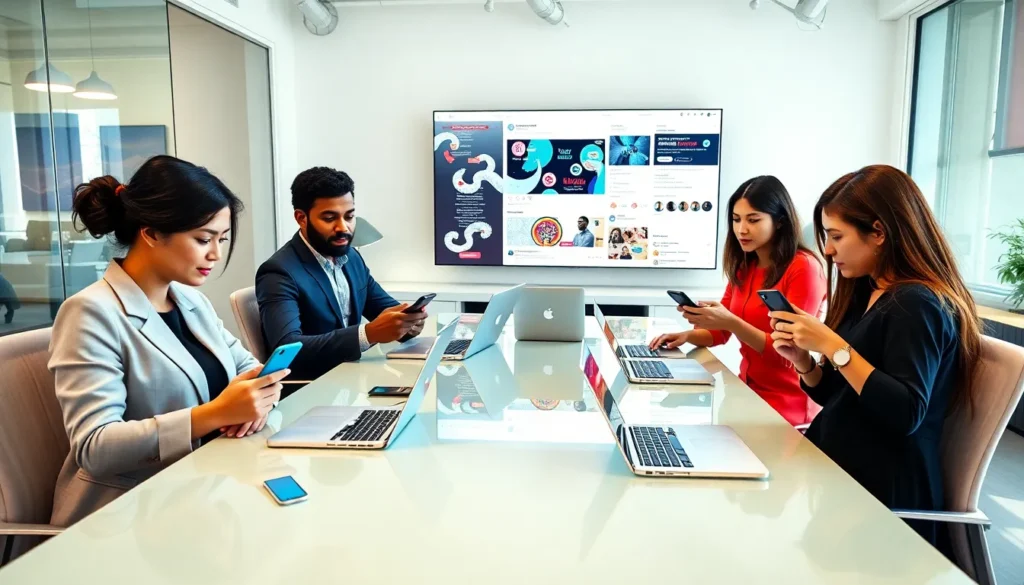In a world where remote meetings have become the new norm, poor video quality can turn even the most riveting presentations into a snooze-fest. Picture this: you’re sharing your brilliant ideas, but all your colleagues see is a pixelated mess that looks like a scene from a bad 90s sitcom. Zoom video optimization isn’t just a techy buzzword; it’s the secret sauce to making sure your virtual presence shines brighter than your morning coffee.
Table of Contents
ToggleOverview of Zoom Video Optimization
Optimizing video quality on Zoom enhances the virtual experience during meetings. High-definition video ensures crisp visuals, improving engagement and communication clarity. Internet bandwidth plays a vital role; higher bandwidth supports better video resolutions.
Zoom offers several settings to enhance performance. Participants can select the HD video option for improved clarity. Using a wired internet connection generally provides more stability than Wi-Fi.
Camera placement matters significantly too. Positioning the camera at eye level creates a more natural viewing experience. Lighting should illuminate the face without causing glare, allowing for better visibility. Using natural light is effective, but supplementing with soft, diffused lighting also improves image quality.
Backgrounds can distract viewers; using a virtual background can streamline focus on the speaker. Zoom’s virtual background feature allows users to customize their meeting environment as needed.
Software updates enable access to the latest features and improvements. Regularly updating Zoom helps to prevent issues that could affect video quality. Reducing background applications can also free up processing power for smoother video.
Incorporating good audio quality complements video optimization. Clear audio paired with sharp visuals facilitates effective communication. Ultimately, the combination of these practices ensures that participants present a professional appearance and create a positive virtual atmosphere.
Techniques for Video Optimization
Optimizing video quality in Zoom requires specific techniques to enhance the viewer’s experience. Implementing these strategies can significantly improve clarity and engagement during virtual meetings.
Adjusting Video Settings
Select the HD video option in Zoom for improved clarity. This feature enhances visual quality, making the video look sharper and more professional. Adjust video settings by navigating to the settings menu and enabling HD under the video tab. Personalize virtual backgrounds or choose plain backgrounds to minimize distractions. Check the camera’s frame rate, as higher rates can improve smoothness. Experiment with video filters to find the most flattering appearance.
Utilizing Bandwidth Efficiently
Choose a wired internet connection for consistent speed and reliability. Switch off bandwidth-heavy applications running in the background to allocate more resources to Zoom. Prioritize video calls by connecting directly to the router using an Ethernet cable. Close unnecessary tabs or applications on the device to free up bandwidth. Set Zoom to turn off video when bandwidth is low; this action ensures clear audio remains uninterrupted. Lower the video quality in settings if issues persist, as this adjustment can stabilize the connection.
Hardware Considerations
Hardware plays a crucial role in optimizing video quality for Zoom meetings. Essential components can elevate the virtual experience significantly.
Recommended Equipment
High-definition cameras offer superior image clarity, allowing detailed visuals during meetings. An external microphone enhances audio quality, ensuring clear communication. Headsets or earbuds improve sound by minimizing background noise. Reliable computers with fast processors support smoother video performance. Additionally, a good internet connection is vital for transmitting video data without interruptions. Upgrading to a wired Ethernet connection can stabilize connectivity, providing a consistent experience.
Setup Tips for Optimal Performance
Positioning the camera at eye level creates a more natural conversation flow. Adequate lighting is essential; using soft, diffused light reduces shadows and enhances visibility. Maintaining a clutter-free background keeps the focus on the speaker. Avoiding bandwidth-hogging applications during meetings ensures more resources are available for video streaming. Regularly checking for software updates helps to utilize the latest performance improvements. Charging devices beforehand ensures a full battery during meetings, eliminating interruptions.
Advanced Features for Improved Quality
Improving video quality on Zoom involves utilizing advanced features effectively. These tools enhance user experience and create a professional atmosphere during meetings.
Virtual Backgrounds and Effects
Virtual backgrounds can reduce distractions, allowing participants to focus on content. Using a clean, simple background enhances professionalism. Zoom offers a library of backgrounds, but users can also upload custom images. Effects like video filters add a fun element, but should complement, not replace, a polished appearance. Proper lighting is essential when using these features, as it helps maintain clarity.
Recording and Streaming Options
Recording meetings allows for reviewing important discussions and sharing with absentees. Users can choose local or cloud recording based on storage preferences. Streaming options enable broadcasting to platforms like YouTube or Facebook Live, reaching larger audiences. Configurable settings allow customization of video quality during recording and streaming. Access to these features empowers users to maximize engagement and share experiences beyond the live session.
Common Challenges and Solutions
Many users encounter connectivity issues during Zoom meetings. Decreased bandwidth from multiple devices can lead to poor video quality. Opting for a wired internet connection significantly enhances stability, so it’s essential for users to prioritize this setup whenever possible.
Another common challenge involves subpar video settings. Several individuals forget to enable HD video. By adjusting settings within Zoom to select HD, users can improve overall clarity and engagement.
Lighting plays a crucial role in video quality as well. Dark environments reduce visibility and distract viewers. Utilizing natural light or affordable ring lights can elevate lighting conditions, enhancing video presence.
Camera positioning also impacts the user’s appearance on screen. Misaligned cameras create awkward angles. Positioning the camera at eye level promotes a more natural viewing experience and fosters better engagement.
Audio quality often goes unnoticed but is just as vital. Poor audio can overshadow good video. Using external microphones, specifically designed for clear sound capture, can drastically improve the overall experience.
Background distractions can detract from the meeting’s focus. Virtual backgrounds serve to minimize interruptions in the visual field. Users should attempt to select simple, professional backdrops that maintain attention on the speaker.
Regular software updates often pose a challenge. Outdated software might cause glitches or connectivity problems. Ensuring Zoom is up to date can resolve many performance-related issues.
Ultimately, users benefit from using supportive hardware. High-definition cameras, external microphones, and quality headsets significantly enhance clarity and focus. Investing in these technologies contributes to a more polished virtual presence.
Conclusion
Optimizing video quality on Zoom is vital for effective communication in remote settings. By implementing the strategies discussed users can significantly enhance their virtual presence. From selecting the right hardware to ensuring stable internet connections every detail contributes to a more professional experience.
Investing time in improving video and audio quality pays off in clearer presentations and better engagement. Regularly updating software and utilizing advanced features can further elevate virtual meetings. With these practices in place individuals can navigate the challenges of remote communication with confidence and clarity.













